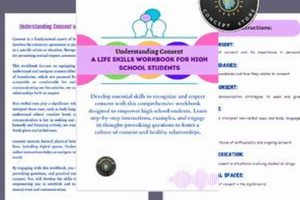Initiation rituals involving harassment, abuse, or humiliation as a prerequisite for joining a group, particularly within a secondary school environment, represent a serious concern. These activities can range from relatively harmless pranks to severe physical or psychological torment, sometimes involving illegal activities. For instance, forcing new members to consume excessive amounts of food or alcohol, perform degrading acts, or endure physical violence are all examples of this harmful practice.
Understanding this problem is crucial due to its potential for long-lasting negative impacts on victims, perpetrators, and the overall school climate. Such practices can lead to physical injury, emotional trauma, and even death. Historically, these rituals have been rationalized as a means of fostering group cohesion and loyalty, but research demonstrates that they often have the opposite effect, creating a culture of fear and resentment. Addressing this behavior directly promotes a safer and more inclusive learning environment for all students.
This article will further examine the various forms these harmful initiation practices take, their underlying causes, and effective strategies for prevention and intervention.
Tips for Addressing Harmful Initiation Practices
The following tips offer guidance for students, parents, educators, and administrators in recognizing, preventing, and responding to harmful initiation rituals within the secondary school environment.
Tip 1: Understand the Problem. Recognize that these rituals are not harmless fun; they can constitute abuse with serious legal and psychological ramifications. Educate oneself on the various forms such activities might take, ranging from subtle forms of intimidation to overt acts of violence.
Tip 2: Open Communication. Encourage open communication among students, staff, and parents. Create a safe environment where individuals feel comfortable reporting incidents without fear of retaliation.
Tip 3: Establish Clear Expectations. Schools should implement clear policies prohibiting these harmful rituals and outlining the consequences for participation. These policies should be communicated clearly to all members of the school community.
Tip 4: Empower Bystanders. Equip students with the tools and confidence to intervene if they witness these activities. Bystander intervention programs can teach strategies for safely and effectively disrupting harmful situations.
Tip 5: Promote Healthy Group Bonding. Foster positive alternatives for building camaraderie and team cohesion within school groups and organizations. Emphasize activities that focus on respect, inclusivity, and positive relationships.
Tip 6: Seek Support. Provide resources and support for victims of these harmful rituals. This can include counseling services, peer support groups, and access to mental health professionals.
Tip 7: Consistent Enforcement. Enforce established policies consistently and fairly. This demonstrates a commitment to creating a safe environment and discourages future incidents.
By understanding the dynamics of these harmful rituals and implementing these strategies, schools can create a more positive and inclusive environment for all students. These preventative measures can significantly reduce the occurrence of harmful initiation practices and promote a culture of respect and safety.
Addressing this issue requires a collective effort. The following section will explore further resources and support systems available to those affected by and seeking to prevent harmful initiation practices.
1. Ritualistic Abuse
Ritualistic abuse within the context of harmful initiation practices in secondary schools refers to the systematic and repetitive nature of harmful acts disguised as tradition or bonding experiences. These rituals, often shrouded in secrecy, create a coercive environment that perpetuates the abuse.
- Degradation and Humiliation
Degrading and humiliating rituals aim to strip individuals of their dignity and reinforce a power imbalance. Examples include forced consumption of unpleasant substances, public performance of embarrassing acts, or verbal abuse. These practices can have profound psychological consequences, impacting self-esteem and mental health.
- Physical Challenges and Endangerment
Physical challenges, often presented as tests of strength or endurance, can escalate into dangerous situations. Examples include forced physical exertion, sleep deprivation, or exposure to hazardous environments. These activities can result in serious physical injuries and even death.
- Secrecy and Oaths
Secrecy and oaths play a crucial role in maintaining the cycle of abuse. New members are often sworn to secrecy, creating a culture of fear and preventing disclosure. This silence protects perpetrators and allows the harmful practices to continue unchecked.
- Exploitation of Vulnerability
Harmful initiation rituals often target individuals in vulnerable positions, exploiting their desire for acceptance and belonging. New students, eager to integrate into a new environment, are particularly susceptible to these manipulative tactics. This power imbalance reinforces the cycle of abuse.
These interconnected facets of ritualistic abuse contribute to the normalization of harmful practices within secondary school environments. Understanding these dynamics is crucial for developing effective prevention and intervention strategies that address the underlying causes and protect vulnerable students.
2. Power Dynamics
Power dynamics play a central role in harmful initiation practices within secondary schools. These rituals often serve to establish and reinforce hierarchical structures within groups, exploiting vulnerabilities and creating an environment conducive to abuse. The desire for acceptance and belonging, particularly among new students, can be manipulated by those in positions of perceived authority within established groups. This power imbalance allows existing members to exert control over newcomers, perpetuating the cycle of abuse. For example, senior members of a sports team might use their perceived status to coerce new recruits into participating in degrading activities, reinforcing their dominance within the team hierarchy.
The very structure of these rituals reinforces these power dynamics. The secrecy surrounding the activities isolates newcomers and prevents them from seeking help or reporting the abuse. The established members, through their knowledge of the rituals and their control over the initiation process, hold a significant advantage. This dynamic can be further exacerbated by factors such as age, social status, or physical size differences, creating a sense of powerlessness among victims. The pressure to conform, even in the face of discomfort or danger, stems from the fear of exclusion and the desire to gain acceptance within the group. In some cases, victims may even internalize the abuse, believing they deserve it or that it is a necessary part of belonging.
Understanding the interplay of power dynamics is crucial for dismantling the structures that perpetuate harmful initiation practices. Interventions must address the root causes of these power imbalances and empower individuals to resist and report abuse. Promoting a culture of respect and equality within school communities can help mitigate the influence of these harmful dynamics and create a safer environment for all students. This requires addressing not only the immediate acts of abuse but also the underlying attitudes and behaviors that contribute to the normalization of these harmful practices. By challenging the existing power structures and fostering a more inclusive environment, schools can effectively disrupt the cycle of abuse and create a more positive and equitable experience for all students.
3. Psychological Impact
Harmful initiation practices in secondary schools can have profound and lasting psychological consequences for victims. These experiences can significantly impact their mental health, academic performance, and overall well-being. Understanding the range of psychological impacts is crucial for developing effective support systems and prevention strategies.
- Trauma and Post-Traumatic Stress
Exposure to traumatic events during these rituals can lead to post-traumatic stress disorder (PTSD). Symptoms may include flashbacks, nightmares, anxiety, and avoidance behaviors. The intense stress associated with these experiences can disrupt normal psychological functioning and require specialized therapeutic intervention.
- Depression and Anxiety
Feelings of humiliation, powerlessness, and betrayal can contribute to the development of depression and anxiety. Victims may experience persistent sadness, loss of interest in activities, difficulty concentrating, and increased irritability. These mental health challenges can significantly impact academic performance and social interactions.
- Damaged Self-Esteem and Body Image
Harmful initiation practices often involve activities that degrade and humiliate individuals, leading to diminished self-esteem and negative body image. Victims may internalize the negative messages they receive during these rituals, impacting their sense of self-worth and confidence.
- Difficulty Forming Trusting Relationships
The betrayal of trust experienced during these rituals can make it difficult for victims to form healthy relationships in the future. They may develop a sense of mistrust towards others, impacting their ability to connect with peers and build supportive social networks.
The psychological impact of harmful initiation practices extends beyond the immediate aftermath of the events. These experiences can have long-term consequences, affecting individuals’ mental health and well-being for years to come. Addressing the psychological needs of victims through counseling, support groups, and other therapeutic interventions is essential for mitigating the negative effects and promoting healing. Furthermore, implementing comprehensive prevention programs can help create a safer and more supportive school environment that protects students from the psychological harm associated with these practices.
4. Physical Harm
Physical harm represents a severe consequence of harmful initiation practices in secondary schools. While not all such rituals involve physical activity, the potential for serious injury or even death underscores the importance of addressing this issue. The physical challenges imposed during these rituals can range from strenuous exercise and sleep deprivation to acts of violence and forced consumption of dangerous substances. These activities can result in a variety of injuries, including broken bones, concussions, alcohol poisoning, and other life-threatening conditions. For example, forcing individuals to consume excessive amounts of alcohol can lead to acute alcohol poisoning, requiring immediate medical attention. Similarly, physically demanding activities performed under duress can result in serious injuries, particularly if individuals are not properly conditioned or are forced to exceed their physical limits. The long-term effects of these injuries can range from chronic pain and disability to lasting psychological trauma.
The connection between physical harm and these rituals lies in the power dynamics and the desire to exert control over newcomers. Physical challenges are often presented as tests of strength, endurance, or loyalty, designed to push individuals beyond their limits. The pressure to conform, coupled with the fear of exclusion, can lead individuals to participate in activities they would otherwise avoid. This dynamic can be particularly dangerous when combined with alcohol or other substances, which can impair judgment and increase the likelihood of risky behavior. Moreover, the secrecy surrounding these rituals often prevents victims from seeking timely medical attention, exacerbating the severity of their injuries. In some cases, the reluctance to report the abuse can stem from fear of retaliation or a sense of shame, further isolating victims and delaying necessary medical intervention.
Understanding the potential for physical harm is crucial for developing effective prevention and intervention strategies. Schools must implement clear policies prohibiting these harmful practices and educate students about the risks involved. Creating a culture of respect and promoting healthy alternatives for team bonding can help mitigate the appeal of these dangerous rituals. Furthermore, providing support and resources for victims, including access to medical care and psychological counseling, is essential for addressing the physical and emotional consequences of these harmful practices. By acknowledging the serious nature of physical harm associated with these rituals, schools can create a safer and more supportive environment for all students.
5. Group Conformity
Group conformity plays a significant role in the perpetuation of harmful initiation practices in secondary schools. The desire for acceptance and belonging, particularly strong during adolescence, creates a powerful incentive for individuals to conform to group norms, even when those norms involve harmful or dangerous behaviors. This pressure to conform can override individual judgment and moral compass, leading students to participate in activities they would otherwise find objectionable. The fear of social exclusion and the desire to gain acceptance within a desired group can be particularly potent motivators. For example, a new student might participate in a humiliating initiation ritual to avoid being ostracized by their peers and gain entry into a popular social clique. Similarly, members of athletic teams might feel compelled to engage in harmful practices to maintain team cohesion and avoid being labeled as disloyal or weak. This dynamic creates a cycle of abuse, as new members who have endured harmful rituals often feel pressure to perpetuate them when they become more senior within the group, ensuring the continuation of the harmful tradition.
The influence of group conformity is further amplified by the presence of authority figures or group leaders who condone or encourage these practices. When coaches, team captains, or other influential individuals explicitly or implicitly endorse harmful initiation rituals, it creates a powerful message that such behavior is acceptable and even expected. This normalization of harmful behavior makes it even more difficult for individuals to resist the pressure to conform. Moreover, the secrecy surrounding these rituals often isolates individuals and prevents them from seeking help or reporting the abuse. The fear of betraying the group or facing retaliation can further silence victims and reinforce the power of the group dynamic. This silence allows the harmful practices to continue unchecked and creates a culture of fear and intimidation.
Understanding the role of group conformity in these rituals is crucial for developing effective prevention and intervention strategies. Efforts to combat this behavior must address the underlying social pressures that contribute to conformity. This includes promoting a culture of respect and inclusivity within school communities, empowering individuals to resist peer pressure, and providing alternative pathways for social belonging that do not involve harmful practices. By challenging the normalization of these harmful traditions and fostering a more positive and supportive school environment, it is possible to disrupt the cycle of abuse and create a safer and more inclusive experience for all students. This requires a collective effort from school administrators, educators, parents, and students to challenge the underlying attitudes and beliefs that perpetuate these harmful practices.
6. Prevention Strategies
Effective prevention of harmful initiation practices within secondary schools requires a multifaceted approach that addresses the underlying causes and promotes a culture of respect and safety. These strategies must involve all stakeholders, including students, educators, administrators, parents, and community members. Implementing comprehensive prevention programs is crucial for creating a positive and inclusive school environment where all students feel safe and valued.
- Education and Awareness
Raising awareness about the nature and consequences of harmful initiation practices is a crucial first step in prevention. Educational programs can inform students, staff, and parents about the various forms such activities might take, the potential physical and psychological harm they can cause, and the legal ramifications involved. These programs can also highlight the importance of bystander intervention and empower individuals to speak out against these harmful practices. For instance, workshops and assemblies can be conducted to educate students on identifying and reporting harmful initiation, promoting positive alternatives to bonding activities, and emphasizing the importance of respect and inclusivity. These educational initiatives can help shift school culture away from tolerance of harmful traditions and towards a more positive and supportive environment.
- Clear Policies and Enforcement
Schools must establish clear and comprehensive policies that explicitly prohibit harmful initiation practices and outline the consequences for participation. These policies should be communicated clearly to all members of the school community and enforced consistently. For example, a school’s code of conduct could explicitly state that any form of initiation involving harassment, humiliation, or physical harm is prohibited, with potential consequences ranging from suspension to expulsion. Consistent enforcement of these policies demonstrates a commitment to creating a safe environment and discourages future incidents. This requires ongoing training for staff and administrators to ensure they are equipped to recognize and respond appropriately to these harmful behaviors.
- Positive School Climate
Fostering a positive and inclusive school climate is essential for preventing harmful initiation practices. This involves promoting respect, empathy, and positive relationships among students. Creating opportunities for students to connect with one another through positive and inclusive activities can help reduce the appeal of harmful initiation rituals. For example, schools can organize school-wide events, clubs, and activities that promote positive social interaction and build a sense of community. These initiatives can help students develop healthy relationships and find belonging without resorting to harmful traditions. Encouraging student leadership in promoting positive school culture can also empower students to take an active role in creating a safer and more inclusive environment.
- Parent and Community Involvement
Engaging parents and community members in prevention efforts is crucial for creating a comprehensive approach to addressing this complex issue. Educating parents about the signs of these harmful rituals and encouraging them to talk to their children about the risks involved can help prevent participation. Community organizations can also play a role in providing resources and support for victims and promoting positive alternatives to harmful traditions. For instance, parent-teacher associations can organize workshops and information sessions to raise awareness about these harmful practices, while local youth organizations can offer mentorship programs and positive social activities for students. This collaborative approach strengthens the school’s ability to address harmful initiation practices effectively.
These interconnected prevention strategies offer a comprehensive framework for addressing harmful initiation practices in secondary schools. By implementing these strategies, schools can create a safer and more supportive learning environment where all students can thrive. The effectiveness of these strategies depends on the commitment of all stakeholders to creating a culture of respect, responsibility, and inclusivity. By working together, schools and communities can effectively address the complex issue of harmful initiation and ensure the well-being of all students.
Frequently Asked Questions about Harmful Initiation Practices
This section addresses common inquiries regarding harmful initiation practices in secondary schools, providing clear and informative responses.
Question 1: What constitutes harmful initiation in a high school setting?
Harmful initiation encompasses any activity expected of someone, often a new member of a group or team, that involves harassment, abuse, or humiliation. This can range from seemingly minor pranks and demeaning tasks to severe physical or psychological torment, sometimes involving illegal activities.
Question 2: Is harmful initiation limited to specific groups or activities?
While often associated with athletic teams and fraternities/sororities, harmful initiation can occur within any school group or organization, including academic clubs, performing arts groups, and even informal social circles. No group is immune.
Question 3: How can one differentiate between harmless fun and harmful initiation?
The key distinction lies in the presence of coercion, harassment, humiliation, or any activity that compromises the physical or emotional well-being of an individual. If an activity causes discomfort, fear, or distress, it likely crosses the line from harmless fun to harmful initiation.
Question 4: What are the legal ramifications of engaging in harmful initiation practices?
Depending on the severity and nature of the acts, legal consequences can range from school disciplinary actions to criminal charges. Both perpetrators and those who condone or enable such behavior can face legal repercussions.
Question 5: What should one do if they witness or experience harmful initiation?
Reporting such incidents to a trusted adult, such as a teacher, counselor, or parent, is crucial. Schools have a responsibility to investigate and address these issues, and support systems are available to assist those affected. Documentation, if possible, can be helpful.
Question 6: How can schools create a culture that prevents harmful initiation?
Establishing clear policies prohibiting these practices, coupled with consistent enforcement and educational programs that promote positive group dynamics and bystander intervention, are crucial steps in creating a safe and inclusive school environment. Open communication and fostering a culture of respect are also essential.
Addressing this issue requires a collective effort. Understanding the dynamics of harmful initiation, recognizing its various forms, and fostering open communication are crucial steps in creating a safer and more supportive environment for all students.
The following resources offer additional information and support for those seeking to understand and address harmful initiation practices further.
Harmful Initiation Practices
Harmful initiation practices in secondary schools represent a serious threat to student well-being. This exploration has examined the multifaceted nature of these rituals, from the psychological impact on victims to the role of group conformity in perpetuating the cycle of abuse. The potential for physical harm, the power dynamics at play, and the critical need for effective prevention strategies have been highlighted. Understanding these complex dynamics is crucial for developing effective interventions and fostering a safer school environment.
Eliminating harmful initiation practices requires a collective commitment from students, educators, administrators, parents, and community members. Creating a culture of respect, promoting healthy relationships, and empowering individuals to resist and report abuse are essential steps toward ensuring the safety and well-being of all students. This ongoing effort demands vigilance, education, and a steadfast commitment to fostering a positive and inclusive school climate where harmful initiation has no place. The future of our schools depends on the collective action taken today to eradicate these harmful practices and protect vulnerable students.







